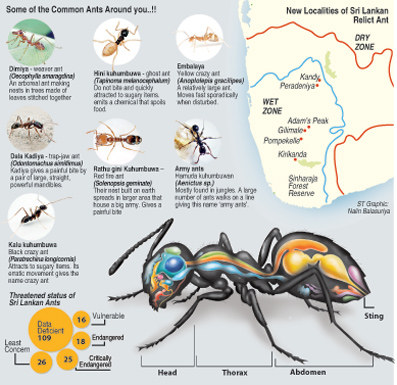News
Tiny ant makes big strides
They are a household nuisance and the sight of lines of ants marching towards food lying about can drive one crazy. But researchers from Peradeniya University studying a group of ants are excited by their discovery. The cause of the excitement was the existence of the rare endemic Sri Lankan Relict Ant (Aneuretus simoni Emery) among the sample of ants being studied.

The Sri Lanka Relict Ant may be one of the tiniest members of Sri Lanka’s unique biodiversity but it has a big reputation. As its name implies, a ‘relict species’ is a surviving species of an otherwise extinct group of organisms.
The Sri Lanka Relict Ant is the only living species of the Genus Aneuretus (genus is a scientific grouping of species that have common characteristics). This tiny creature has therefore grabbed the attention of entomologists around the world including that of prof. Edward O. Wilson, known as the father of biodiversity. He had even come to Sri Lanka to study this ant a few decades ago.
This ant was first discovered in Kandy as far back as 1892. In addition to Kandy they are found only in a few places including Pompekelle, Gilimale, Adam’s Peak and Peradeniya, all in the Wet Zone
The latest finding was made by young researcher Nuwan Karunarathna who is doing his undergraduate studies under Dr. Inoka Karunaratne of the University of Peradeniya. Nuwan’s research involved analysing the diversity of ant species in two forests in the Knuckles range. This resulted in discovering 48 species of ants including the Relict Ant from the Moraella lowland rain forest near Panwila, and 35 species from the Rambukoluwa semi evergreen forest.
This is also the first time the ant has been recorded in the Intermediate Zone according to the paper authored by Nuwan and Dr. Karunaratne and published in last month’s prestigious Journal of Threatened Taxa.
The Relict Ant nests are found inside rotting and crumbling pieces of wood or in logs fallen on the ground. An ant colony consists of different levels of members of social strata including the queen and workers. According to researchers The Relict Ant colonies have two types of worker ants–major workers and minor workers. Usually an ant colony consists of thousands of worker ants, but in this species, the number of workers is less than hundred. Studies have shown that colonies are composed of 18-106 minor workers and one to three major workers, says Nuwan. Some colonies could also contain more than one queen.
Last year, Prof. Sriyani Dias of Kelaniya University too had found the Relict Ant in a forest patch in Kalutara. Prof. Dias who has been studying the etymology of ants in Sri Lanka since 2000 says more research needed to be done. According to the National Red List 2012, the conservation status of 109 ant species – more than half of the known species, were categorised as ‘Data Deficient”.
The Relict Ant has been listed as ‘Critically Endangered’ by the International Red List. However, perhaps due to its discovery in a few locations in Sri Lanka, its threatened level has been elevated to ‘Endangered’ in the National Red List published in 2012. The National Red List however has categorised 25 ant species in Sri Lanka as ‘Critically Endangered” with habitat loss being the major threat.
Robert Knox on our ‘coumbias’
According to researchers systematic studies on ants in Sri Lanka were started in 1903. However, it is interesting to note that documenting ant species goes as far back as to the time of the famous British prisoner Robert Knox. In his book ‘An Historical Relation of Ceylon (1681)’ he mentions seeing six ant species in Sri Lanka.
“There are ants of several sorts, and some worthy of our remark. First of all there are the ‘coumbias’ a sort of small reddish ants like ours in England” Knox penned. He also mentions Tele-coumbias, Dimbios (dimiya), Coddia (kadiya) and termites.
Prof. E. O. Wilson, known as the ‘Father of Biodiversity’ commenting on the Sri Lanka Relict Anton Wikipedia in 1994 says, “Twenty years later it is found the species rare or absent in the same localities.” Recommending the Sri Lanka Relict Ant in the IUCN Red Data Book, the eminent professor says, “In time it became one of the first of several ants to be officially classified as a threatened or endangered ant species.”
comments powered by Disqus
